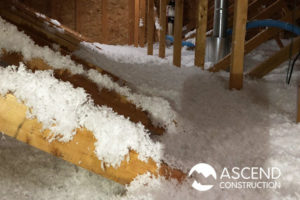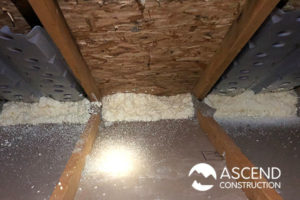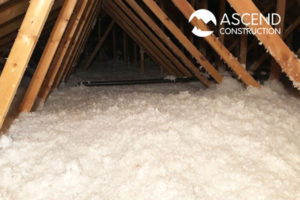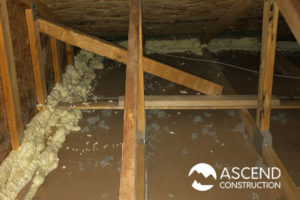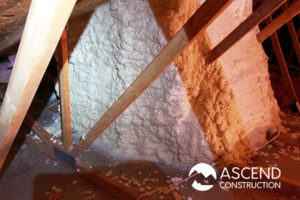Attic insulation is essential for controlling the stack effect and keeping your conditioned air where you want it (in your home!). This is a crucial element for an energy-efficient Colorado home that is comfortable all year long. The team at Ascend Construction can show you how to save you money and improve the comfort and energy efficiency of your home.
Why Consider An Upgrade To Your Attic Insulation?
Contact Ascend Construction today for a free, in-home assessment of your attic's current insulation. We will provide a quote to enhance the energy efficiency of your Colorado home and advise you with regards to any available energy rebates and/or tax credits.
REQUEST A FREE, NO-OBLIGATION QUOTE!
"*" indicates required fields
Prior Attic Insulation Projects In Colorado
Colorado Attic Insulation FAQs:
Affordable - Better R-Value - Quick Installation
Blown-in insulation is better for attic applications as the cellulose is blown between studs, offering a more thorough coverage.
This is the preferred method of insulating attic spaces when the desired result is an improved R-value. This method is far superior to the typical insulation batts that a home builder installs.
After the old insulation is removed and all the air gaps are sealed tight with spray foam insulation, the blown-in attic insulation with cellulose can be installed in less than one day. A complete job for a typical Colorado home usually takes two days or less to complete. Read more...
Attic Insulation Contractors In Colorado
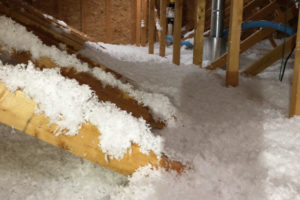 Typically, the goal of attic insulation is to help prevent the outdoor heat from permeating through your roof to your attic and then into your living space. Besides, attic insulation prevents indoor heat from escaping during cold weather. So installing insulation in your attic makes your house more energy-efficient, and hence, it's a vital project for homeowners who want to save energy.
Typically, the goal of attic insulation is to help prevent the outdoor heat from permeating through your roof to your attic and then into your living space. Besides, attic insulation prevents indoor heat from escaping during cold weather. So installing insulation in your attic makes your house more energy-efficient, and hence, it's a vital project for homeowners who want to save energy.
If you want to save on your energy bills, you don't necessarily have to waste time searching for home insulation companies. Instead, contact Ascend Construction today to speak to a certified insulation contractor about your attic insulation needs.
Colorado Attic Insulation Cost
The cost to insulate an attic varies depending on the size of the space that needs to be covered, and the insulation material you'll choose.
Blown-in insulation is a cost-effective option so you should consider getting a blown in insulation cost estimate. The costs will also be impacted by where you live; every house is different and every county and city has different code regulations.
At Ascend Construction, we will advise you of the building codes in your area for R-value as well as vapor barrier requirements.
Additionally, we will assist you in applying for and obtaining any rebates and other costs savings for your Colorado insulation project. These vary based on state incentives as well as individual municipalities.
Best Insulation For Attic in Colorado
There are two main insulation types: batt and roll insulation and blown in insulation.
Batt and roll insulation is effective in crawl spaces and wide-open spaces. Many housing builders use this method because it is cheaper than cellulose insulation.
Conversely, blown in insulation like cellulose insulation is effective in extremely tight spaces or where insulation has been installed but needs to be topped off. It's also effective in filling wood joists.
In Colorado, attic insulation will likely entail insulating tight spaces. Blown in insulation works perfectly in this case because it covers smaller spaces better, it offers great R Value, it's eco-friendly, and it's more cost-effective compared to batt and roll insulation. Blown in insulation however requires a special machine and some expertise, so you should ideally work with a professional.
At Ascend Construction, we provide the absolute best insulation solutions which is why we utilize the combination of foam insulation for sealing gaps and blown in cellulose insulation.
Attic Insulation FAQs
How much insulation do I need in my attic?
To figure out the level of insulation you need, you should measure the width times the length of your attic space to insulate in order to calculate the square footage. You also need to determine the suitable R-value for the insulation project.
Simply put, R-value denotes the thermal resistance of a given material or, in other words, the level at which the material resists heat flow. The rule of thumb is, the greater the R-value, the more effective the insulation is in keeping cold or warm air in or out of the insulated space.
However, it is worth noting that the ideal R-value will vary based on the climatic conditions in your area. The US Department of Energy has designated 8 climate zones and it recommends a different R-value for each of these zones for different areas of a house including for attics and basements. Due to the varying climate conditions in Colorado, the state is divided into four climate zones.
Climate Zone 4 encompasses 3 counties. Climate Zone 5 covers 33 counties, while Climate Zone 6 and 7 encompasses 13 counties each.
Some counties experience severe winters and thus require insulation that has a higher R-value. The ideal R-value also depends on whether any other insulation has been installed before the procedure. An attic that has never been insulated before will require a higher R-value for effective insulation. Therefore, the right level of insulation is mainly hinged on R-values and square footage.
Contact Ascend Construction for a precise quote on your attic insulation needs.
How much does attic insulation cost?
The cost will be dependent on the material used, the size of space covered, and R-value requirements.
To get a precise cost estimate, call Ascend Construction today.
How long does attic insulation last?
Blown in insulation like cellulose insulation is much more effective in blocking air. It's also eco-friendly, and cost-effective compared to other insulation types, but it starts to degrade after 20-30 years.
Like other insulation types, outside interference and severe weather can impact the lifespan.
How to walk in attic with blown insulation?
To walk in an attic with blow in insulation you have two options:
First option: Get into the attic and stand on a sturdy point. Then you should carefully remove the insulations. You must ensure the joists are properly handled and the insulations are not amalgamated. After you've removed the insulations you can then walk to the place you want to access. Once done with the work, you can carefully return the insulations into position, get out, and close your attic.
Second option: This option is less messy and more efficient. First, find a set of suitable wooden walking planks/boards. Ensure they are robust enough to hold up your weight.
Once you've found the right walking boards you have two options:
You can place the planks right on the insulation. In this case, if your insulation is not thick enough, some of its insulation efficiency may be lost. There is also a possibility that the insulation may go through a crack underneath.
You can lay the wooden planks on the joists and create a stricture that's similar to a catwalk. With this option, your maintenance personnel won't struggle walking through your attic, and the risk of your insulation losing effectiveness is minimal.
What To Expect With An Attic Insulation Project Done By Ascend Construction
When working with Ascend Construction on your attic insulation job, you get the opportunity to know your attic air sealing and insulation work is being completed to the highest of standards.
Standard attic jobs all follow the same general order of events:
Insulation Removal
Our crews will arrive on-site to begin your job by removing all existing insulation in your attic. This is done to gain full access to all areas of air leakage into your home. Typical air leakage points are areas where an exterior or interior wall lies beneath the attic floor. We can tell where these walls are located from inside your attic as we can see the framing members of the walls called "top plates" in between drywall. Other main areas of air leakage are all wire penetrations to fans, lights, smoke alarms, etc. as well as bath fans, can lights and other ceiling penetrations.
Two-Part Closed Cell Spray Foam Insulation
After vacuuming all insulation out of the attic, we then spray two-part closed cell spray foam over all air leakage points. We use only two-part closed cell spray foam as this product is of the most durable and long lasting on the market. Products found in hardware stores (canned foam insulation) simply do not have the durability to last in the extreme temperatures an attic faces and quickly deteriorates.
Knee Wall Insulation
Next, we spray foam over any knee walls that exist in an attic. Knee walls are areas of your ceiling beneath an attic, where the ceiling height changes. This creates a vertical wall inside the attic that is oftentimes left open to the unconditioned attic space. At Ascend, we spray two-part closed cell spray foam over the entirety of your knee wall to air seal over the top of any existing batt insulation as well as to provide additional R-value to your wall system.
Loose Blown Attic Insulation Installation
After spray foam is complete, Ascend will blow new loose blown attic insulation into your attic up to current R-value codes. Most insulation codes in Colorado range between R-50 to R-60 which averages 16"-20" of insulation.
Do you know if your attic is up to current insulation codes? Give Ascend Construction a call to provide a free in-home estimate today.
We service the following towns and cities:
Click here for a complete listing of all the towns and cities we service in Colorado and Wyoming.

